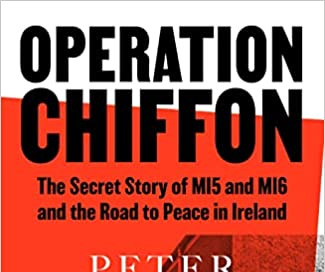Peter Taylor, Operation Chiffon: The Secret Story of MI5 and MI6 and the Road to Peace in Ireland, Bloomsbury, 2023 (Amazon - Bookshop.org)
The story of the covert contacts which initiated the Irish peace process has now been told many times, not least by Peter Taylor himself, in his trilogy on the Troubles, Provos, Loyalists and Brits, and in 2011's Talking to Terrorists.
Among more academic works, the most important is Niall Ó Dochartaigh's Deniable Contact, recently published in paperback, and notable in part because of its use of the private papers of Brendan Duddy, the Derry businessman who served for decades as the key intermediary in the back-channel between the IRA and British intelligence.
Duddy's death in 2017 gives Taylor's return to the subject an elegaic tone, reinforced by the passing of many other peace process players.
Taylor had known and reported on many of these figures from the early years of the Troubles, although he did not meet Duddy until 1998, and it would take another decade before he was able to make Duddy's role public.
The key justification for this book is a scoop that was similarly long in gestation, the first public testimony of 'Robert', the British intelligence officer who passed the most significant, and controversial, messages along Duddy's back-channel during 1993.
Intriguingly Robert worked during his career for both MI5 and MI6, offering a potentially unique insight into two intelligence services often seen as rivals in Northern Ireland.
There is some oblique commentary on this rivalry in Taylor's account of the first intelligence contacts with the IRA in the early 1970s. The prevailing strategy of the time, internment and deep interrogation, was described by MI6 officer Frank Steele as 'damned stupid as well as morally wrong'. What's left unsaid is that MI5, through their director of intelligence at Army Headquarters Northern Ireland, were up to their neck in these policies.
It was another MI6 officer, Michael Oatley, who established the back-channel through Duddy which helped bring about an abortive IRA ceasefire in 1975. Oatley remained in contact with Duddy after leaving Northern Ireland, and took part in attempts to negotiate a resolution to the 1980 and 1981 hunger strikes. Some republicans have blamed Sinn Féin for the failure of those attempts, but Taylor's account is clear that the hunger strikers were in control of their own strategy, and Mrs Thatcher's intransigence was the ultimate roadblock to a deal.
On the point of retirement in 1991, Oatley held an unauthorised direct meeting with Martin McGuinness, forcing decisions to be taken about the future of the back-channel. A number of existing accounts shed light on what happened next, when Oatley reported his contact to John Chilcot at the Northern Ireland Office.
Jonathan Powell, Tony Blair's chief of staff and Northern Ireland pointman reports that 'Stella Rimington, then the Director General of the Security Service, (MI5), was vehemently opposed to the idea of the SIS [MI6], which was normally confined to operations overseas, treading on their turf in this way, but the Security Service's Director and Co-ordinator of Intelligence in Northern Ireland, who had worked closely with Oatley on Arab terrorism, supported the initiative. Still, MI5 insisted that the operation had to be mounted by one of their staff and found for the role a retired senior SIS officer who had recently been re-employed by the Security Service' (ref 1, p.71).
Similarly Stephen Dorril's history of MI6 states that 'although, when the retiring Oatley passed on the mantle to an MI5 officer, he had the support of the MI5 Co-ordinator of Intelligence in Northern Ireland, John Deverell, the process faced near collapse following the death of Deverell in a helicopter crash. MI5 Director-General Stella Rimington was a hardliner who briefed Prime Minister John Major that McGuinness and Adams were IRA members and could not be trusted' (ref 2, p.741).
Taylor confirms the reality of this MI5-MI6 power struggle, while playing down its consequences, in line with the testimony of his key source. 'Robert', the compromise candidate who ran Operation Chiffon, the MI5 iteration of the back-channel, records that it initially began under Rimington's predecessor, Patrick Walker, and that she was 'fully supportive' when she took over.
Nevertheless, like Oatley, 'Robert' took a remarkably Burkean view of his representative role. In March 1993, he met Martin McGuinness and Gerry Kelly in defiance of direct orders from Deverell. The head of MI5's Northern Ireland Counter-terrorism branch, Stephen Lander, only found out the meeting had gone ahead from intelligence sources. 'Robert' was forced to resign as the back-channel broke down in acrimony. Ironically, the public exposure of all sides' appetite for peace proved a crucial step forward.
Operation Chiffon revealed all of the paradoxes of the representative function, with every participant exposing themselves to the charge of treachery from one side and subversion from the other. They achieved a brief spark that ignited the brushwood provided by many other conversations, such as the Hume Adams dialogue and the Brooke talks, into the fire of the peace process.
Some of Taylor's revelations suggest new questions which it may fall to future archival historians to investigate. We are nevertheless fortunate that he has chronicled this story so doggedly for so long.
References
Ref 1: Jonathan Powell, Great Hatred Little Room: Making Peace in Northern Ireland, The Bodley Head, 2008.
Ref 2: Stephen Dorril, MI6: Inside the Covert World of Her Majesty's Secret Intelligence Service, Touchstone, 2000.




